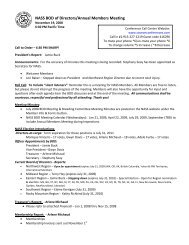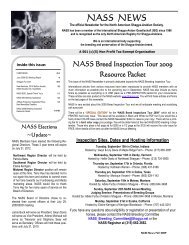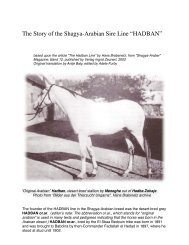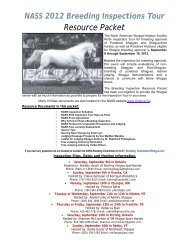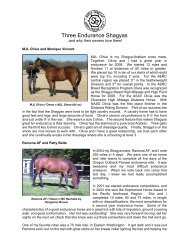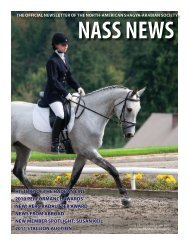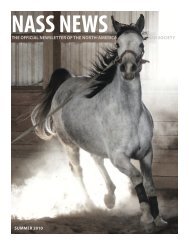NASS Newsletter June 2009 - North American Shagya-Arabian ...
NASS Newsletter June 2009 - North American Shagya-Arabian ...
NASS Newsletter June 2009 - North American Shagya-Arabian ...
Create successful ePaper yourself
Turn your PDF publications into a flip-book with our unique Google optimized e-Paper software.
Why do <strong>Shagya</strong> horse owners choose the <strong>Shagya</strong> breed?<br />
By Patricia Betts<br />
<strong>Shagya</strong> owners choose the <strong>Shagya</strong> breed not<br />
only because they like the looks of the horse<br />
they see, they know that these qualities are<br />
backed by judicious requirements of the International<br />
<strong>Shagya</strong> Registry (ISG). The ISG requires<br />
inspections and horses must meet minimum<br />
standards before being approved for<br />
<strong>Shagya</strong> breeding.<br />
A <strong>Shagya</strong> is bred for elegant type, great hardiness<br />
and toughness, endurance, easy keeping,<br />
and inborn friendliness toward humans as part<br />
of a quality modern riding horse. These qualities<br />
are what attract people to the <strong>Shagya</strong><br />
breed. But it is the rigorous registry process<br />
and resulting controls on breeding stock that<br />
helps increase the odds that they will actually<br />
get these qualities in a <strong>Shagya</strong> horse. The registry<br />
process convinces people to own a<br />
<strong>Shagya</strong>. <strong>Shagya</strong> lovers and owners know that<br />
a registered <strong>Shagya</strong> is much more likely to<br />
carry and consistently produce these qualities.<br />
Why do <strong>Shagya</strong>s have such a reputation?<br />
Inspections and standards for breeding stock is<br />
one reason.<br />
Are inspections important?<br />
<strong>Shagya</strong>s are different from most horse breeds<br />
because breeding stock must be inspected and<br />
approved in order for their offspring to be eligible<br />
for registration as a "Purebred <strong>Shagya</strong>-<br />
<strong>Arabian</strong>" the "official" name for a <strong>Shagya</strong> in an<br />
ISG member <strong>Shagya</strong> Registry. Inspections<br />
provide quality assurance and quality control.<br />
The <strong>Shagya</strong> breed is based on hundreds of<br />
years of a systematically managed Austro-<br />
Hungarian government breeding program – a<br />
program to improve and maintain breed quality.<br />
Each breeding horse was selected and evaluated<br />
based on its presentation of the desired<br />
<strong>Shagya</strong> qualities and its ability to reproduce<br />
those desired qualities. With each generation,<br />
this structured and managed program produced<br />
increasingly more consistent and predictable<br />
qualities in the <strong>Shagya</strong> horses.<br />
Inspections of breeding stock were not invented<br />
in the United States. European warmblood<br />
breeders have used this system of inspections<br />
for years and this is one of the reasons that<br />
horsemen the world over buy their sport horse<br />
prospects from German, Swedish, Dutch and<br />
Danish breeders. Inspections have been an<br />
integral part of the International <strong>Shagya</strong> registry<br />
for over 25 years; an even more rigorous selection<br />
process occurred prior to that. Inspections<br />
in the U.S. adhere to the specific rules overseen<br />
by the International <strong>Shagya</strong> Registry.<br />
People who know the <strong>Shagya</strong> breed would<br />
agree that <strong>Shagya</strong>s more consistently produce<br />
their breed qualities than almost any other<br />
horse breeding program. Consistency will<br />
never be 100%. Improved consistency and<br />
predictability of desired type is achievable and<br />
worth striving for.<br />
<strong>Shagya</strong>s are an international breed with an<br />
international identity and reputation. The <strong>NASS</strong><br />
-registered purebred <strong>Shagya</strong>s in the U.S. are<br />
part of that international gene pool now and in<br />
the future. A quality breeding program is rightfully<br />
a high priority for the International <strong>Shagya</strong><br />
organization and has a huge effect on the<br />
<strong>Shagya</strong> breed today and in the future. As we<br />
consider what is best for the <strong>Shagya</strong> breed now<br />
and into the future, we must consider our<br />
horses today and those horses representing the<br />
breed in the future.<br />
Are inspections reliable for evaluating<br />
horses?<br />
Many different activities use human judges and<br />
a points system to rate an animal, a performance,<br />
or a product. Are inspections perfect?<br />
Absolutely not. Are they an accepted approach?<br />
Yes. Are inspections a valuable tool<br />
to help us maintain the qualities of this great<br />
breed that we all value? Yes. Let’s examine<br />
this a little more.<br />
Inspections are a tool. Without any kind of<br />
screening process, the <strong>Shagya</strong> breed would<br />
risk following the path that so many other horse<br />
breeds and domesticated animals have followed<br />
– selection based on the interests of the<br />
market. The market has influenced horses to<br />
be bred for a certain characteristic that may<br />
sometimes be at the expense of a correct conformation<br />
or proper function. Not only might<br />
any number of undesirable qualities slip into our<br />
breeding stock, but the reliability of producing<br />
the breed’s desired qualities would also be<br />
lowered. The wonderful strengths of the<br />
<strong>Shagya</strong> would slowly disappear with each generation.<br />
Can inspections be improved?<br />
Certainly. Inspectors are ISG trained and certified.<br />
There are many adjustments that could be<br />
made to improve inspections. One simple<br />
change would be to increase the number of<br />
foreign inspectors used. For now, there are not<br />
enough eligible horses to participate to afford<br />
an increase, but this one change could help<br />
improve confidence in inspector objectivity. It<br />
could also improve confidence that assessments<br />
are consistent and inspection protocols<br />
are followed. Other improvements to the current<br />
inspection process could be explored.<br />
Are inspections a reasonable expense?<br />
Inspections have always been a part of the<br />
purebred <strong>Shagya</strong> registry. They do cost money<br />
both to the <strong>Shagya</strong> organization and to <strong>Shagya</strong><br />
owners. Inspections provide a valuable registration<br />
certification at the end – one which gives<br />
prospective owners important information about<br />
the <strong>Shagya</strong> qualities of the horse they are considering<br />
buying or breeding. People value predictability.<br />
When people buy a young or untrained<br />
horse, they invest a lot of money before<br />
they ever know if that horse is going to be<br />
suited for their sport of choice or their breeding<br />
program. Improved predictability and consistency<br />
has great value. Considering their importance<br />
to the breed’s reputation and their potential<br />
effect on sale value, inspections are a reasonable<br />
and necessary expense.<br />
Closing<br />
We all strive to preserve the qualities of the<br />
<strong>Shagya</strong> horse. That is the essence of the<br />
<strong>Shagya</strong>. Inspections are a valuable tool that<br />
helps us preserve those qualities. Inspections<br />
are not so much an expense as an investment<br />
and adherence to standards that have made<br />
the <strong>Shagya</strong> what it is today.<br />
Anything different is not a <strong>Shagya</strong>.<br />
For more information about the <strong>Shagya</strong> breed<br />
please visit the <strong>NASS</strong> website:<br />
www.<strong>Shagya</strong>.net<br />
2 <strong>NASS</strong> News Spring <strong>2009</strong>



